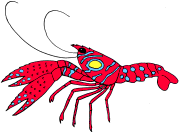
Enoplometopus callistus Intès & Le Loeuff, 1970
ILLUSTRATIONS. - • Specimen from Canary Island, after Wirtz (1996: 369), photo R. Herrera. Copyrigth R. Herrera. • Specimen from Canary Island, after González Pérez (1995: 133, photo 76 by A. Brito). Copyright J.A. González Pérez/Publicaciones Turquesas S.L.
REFERENCES. - Enoplometopus callistus Intès & Le Loeuff, 1970: 1442 (Type locality: gulf of Guinea, Ghana, off Takoradi, 5° 30'N, 2° W, 48 m).
Enoplometopus (Hoplometopus) callistus - Holthuis, 1983: 282 (Subgenus Hoplometopus).
Enoplometopus callistus. - González Pérez, 1995: 136, photographs 76–77 (Canary Islands, 30 to 120–140 m; photograph 77 showing a specimen with unusual strong red color; also previous references from these Islands by Barquín et al., Santaella, Santaella et al.). - Wirtz & Herrera, 1995: 116 (Canary Islands: Tenerife, Gran Canaria, 40–200 m). - Wirtz, 1996: 368 (Canary Islands: La Palma, Tenerife; 40–200 m). - Chan & Yu, 1998: 190 (Key).
Enoplometopus biafri Burukovsky, 1972: 180 (off the Niger delta, Nigeria, 4° 02' - 4° 02' 9" N, 6° 30' - 6° 35' 5" E, 40–50 m; junior synonym of Enoplometopus callistus, cf. Holthuis, 1983: 281). - Burukovsky, 1983: 153 (Key).
Hoplometopus callistus - De Saint Laurent, 1988: 61 (List).
LOCATION OF TYPES SPECIMENS. - Muséum national d'Histoire naturelle, Paris (MNHN holotype As 51).
MATERIAL EXAMINED. - West Africa, gulf of Guinea: Ghana, off Takoradi, coll. fishermen, May 1968, trawl 48 m, 1 male cl 42 mm (Type specimen, MNHN As 51); 'market' 18/12/1967, 1 male cl 45 mm, 1 female cl 53.5 mm (MNHN As 627).
CARAPACE. - Lateral edge of rostrum with three spines, or four spines (sometimes with a tiny fifth spine, unilaterally). Carapace armed with five median spines; one postcervical spine; two lateral spines; one intermediate spine; one supra-ocular spine (see remarks).
CHELIPEDS (P1) & AMBULATORY LEGS (P2 to P5). - Chela broad and compressed, about 3 times as long as wide (chela broader in male: on material examined proportions are 2.6–3.0 times longer than wide for 2 males, and 3.9 for one female); dactyl of cheliped with spines and tubercles on outer margin; spines disposed over the full length (9–10 spines on male holotype, but distal spines only in larger specimens); upper and lower faces of chela with tubercles. Dactyl of second pereiopod long, about 0.3 times as long as propodus; carpus without distoventral spine.
ABDOMEN & TELSON. - Pleurae of abdominal somites II to V with a sharp, posteriorly curved median tooth. Anteroventral margins of pleurae II to V finely denticulated. Posterior margin of sixth abdominal tergite smooth or tuberculated, but without true spines. Male first pleopod without distal or subdistal indentation (distal margin oblique, finely serrated; inner margin with median indentation). Telson with two lateral spines; and two distolateral spines (see remarks).
COLORATION. - Ground color of body orange red (antennae white). Lateral face of carapace with numerous non-ocellated spots or patches. Ambulatory legs orange red with narrow white bands. Abdomen with non-ocellated spots or patches.
DISTRIBUTION. - East Atlantic: Gulf of Guinea (off Ghana, off Nigeria); Canary Islands (Cran Canaria, La Palma, Tenerife). Deep distribution: 30–200 meters.
REMARKS. - Arrangement of spines on the carapace and telson is based on material examined in Paris collections. It differs slightly from original description given by Intès & Le Loeuf (1969): 2 postcervical spines (only 1 observed); 4 median spines (5 observed, posterior one being on the cervical groove, as in E. crosnieri); and lateral margin of telson with 3 lateral spines plus 1 posterolateral spine (2 median and 2 distolateral observed).
Spinulation of outer margin of dactyl of chela, used in this work as a specific character, can however vary with size. This margin has 9–10 spines on male holotype (cl 42 mm), but distal spines only in two larger specimens examined (cl 45–53.5 mm).
In E. callistus the white color of the antennae appears to be a good specific character for recognizing the species (P. Wirtz and R. Herrera, personnal communication).
Cite this publication as: Joseph POUPIN (2002 onwards).Tropical reef lobsters of the genus Enoplometopus: Descriptions, Illustrations, Identification, and Information Retrieval, using the DELTA format. Version: 30 May 2002. At http://biomar.free.fr/enoplometopus/.